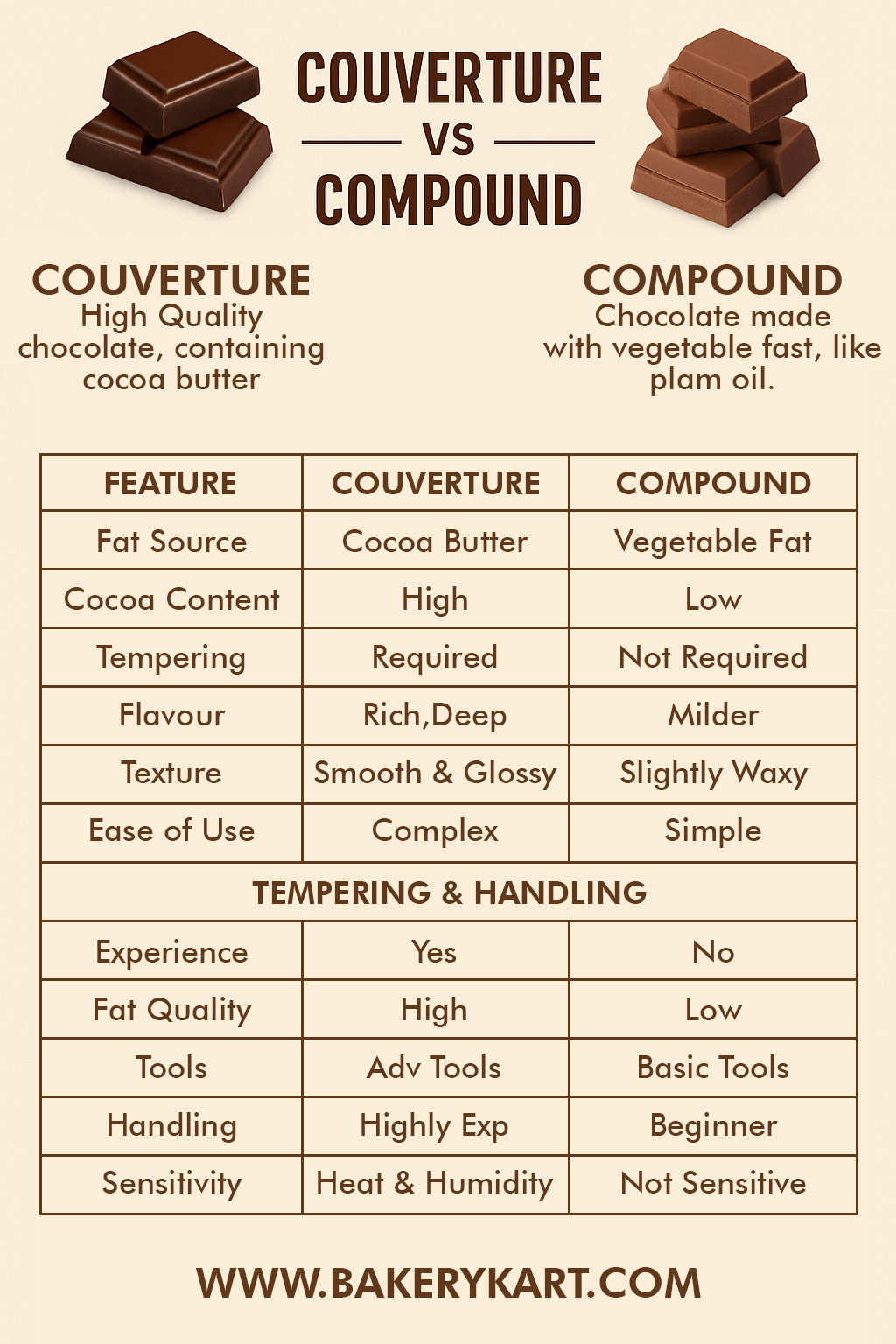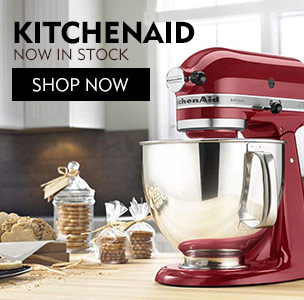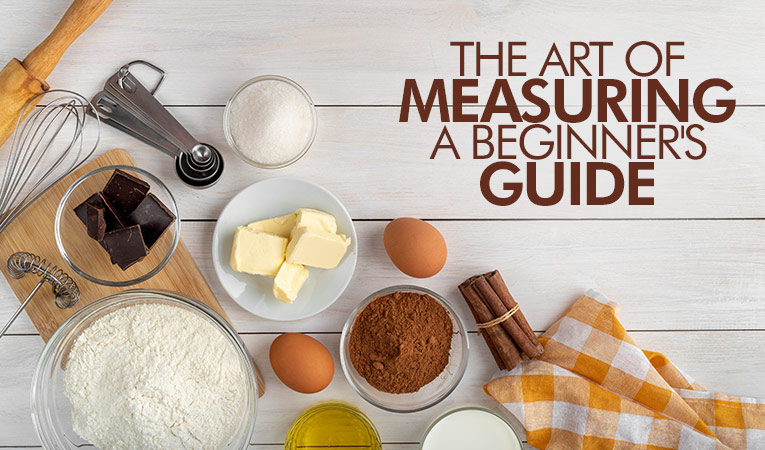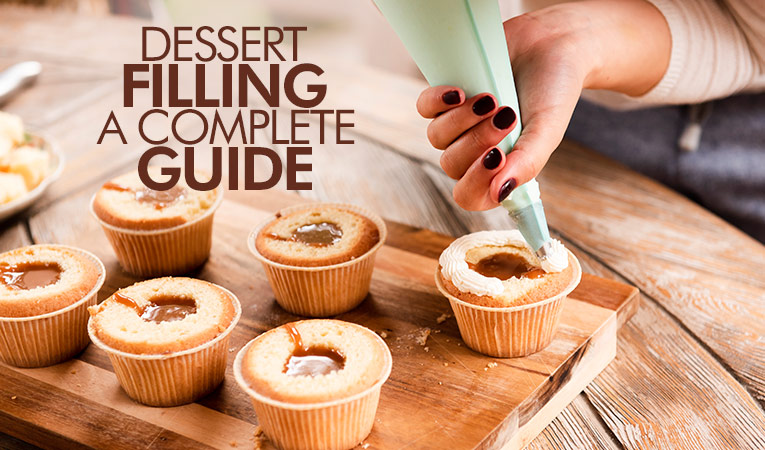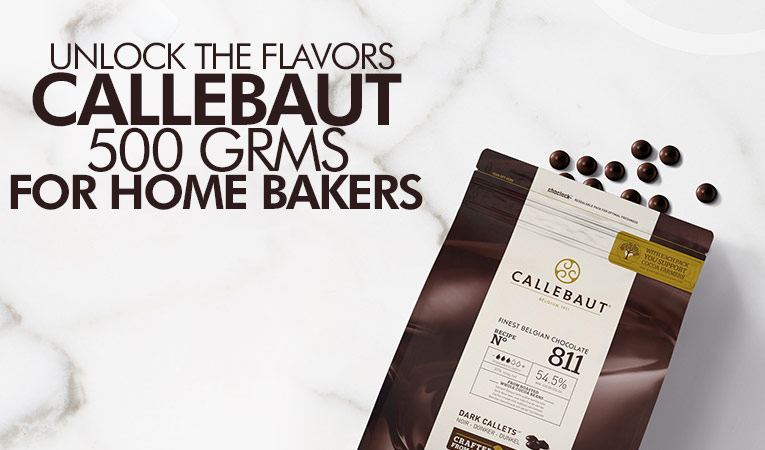Couverture Chocolate vs Compound Chocolate: What Every Baker Should Know
30-06-2025
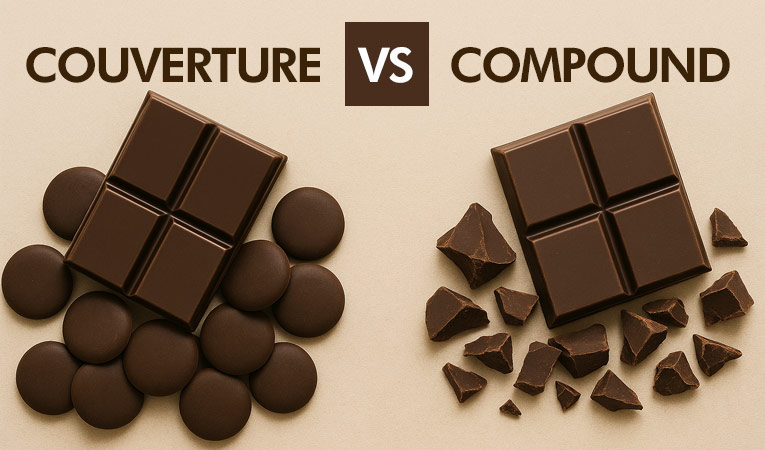
Understanding the difference between couverture chocolate vs compound chocolate is essential for anyone involved in baking, whether as a professional chef or a passionate home baker. Chocolate plays a foundational role in dessert making, from silky ganache layers hidden within celebration cakes to the gleaming coating that gives artisan truffles their visual and textural appeal. Although many chocolates may appear alike, the kind of chocolate you use greatly influences the outcome of your recipe. Texture, flavor intensity, melting behavior, and visual presentation are all directly affected by the chocolate’s formulation. Couverture and compound chocolate are two of the most widely used types in the baking world, and while they serve similar purposes on the surface, their internal structure and culinary roles are very different. Selecting the right chocolate can be the difference between a good dessert and a remarkable one, which is why this distinction deserves close attention.
The composition of each chocolate type determines its ease of use and the quality it delivers in a finished product. Couverture chocolate contains a higher percentage of cocoa butter and cocoa solids, which results in a more refined taste and a smoother mouthfeel. It requires tempering to align the cocoa butter crystals, allowing for a glossy finish and crisp snap that is essential in high-end pastry work. Compound chocolate, by contrast, is formulated with vegetable fats and cocoa powder, which allows it to be melted and used directly without tempering. This convenience makes it popular for quick coatings and decorative work where simplicity is important. In this blog, we will explore every aspect of couverture chocolate vs compound chocolate, from ingredients and handling to applications and taste, helping you make the best choice for your next baking project.
What is Couverture Chocolate
Couverture chocolate is a high-quality variety of chocolate that contains a greater percentage of cocoa butter than regular chocolate. According to international standards, couverture chocolate must have at least thirty-one percent cocoa butter and a minimum of thirty-five percent cocoa solids. This elevated cocoa butter content is what gives couverture its exceptional fluidity when melted, as well as the smooth and glossy finish that professional chocolatiers desire in their confections. Unlike baking chocolate or chocolate chips which are formulated for stability during baking, couverture is intended for applications that highlight its aesthetic and textural properties such as dipping, molding, and creating fine decorations.
The ingredient composition of couverture chocolate typically includes cocoa mass, cocoa butter, sugar, and an emulsifier such as soy or sunflower lecithin. Some premium variants may also include natural vanilla for enhanced flavor. Because it uses real cocoa butter rather than vegetable fats, couverture offers a rich, intense chocolate flavor and a silky mouthfeel that elevates any dessert. However, it requires tempering before use. Tempering is a controlled heating and cooling process that aligns the cocoa butter crystals into a stable form known as the beta crystal. This structure gives couverture its desirable qualities such as a glossy sheen, firm snap, and resistance to bloom.
Professional pastry chefs prefer couverture for ganache, enrobing truffles, chocolate bars, mirror glazes, and other high-end pastry work where visual presentation and taste are equally important. Brands such as Callebaut, Valrhona, and Vanleer offer couverture chocolate in various formats like callets, blocks, and pistoles, catering to both small batch users and commercial kitchens. For bakers aiming to achieve refined results, couverture chocolate is often the top choice due to its premium quality and superior behavior during tempering and cooling.
What is Compound Chocolate
Compound chocolate is a versatile and cost-effective alternative to couverture chocolate that is widely used in both home baking and commercial food production. Unlike couverture, which relies on cocoa butter as its primary fat source, compound chocolate is made using vegetable fats such as palm kernel oil or hydrogenated fats. It also contains cocoa powder instead of cocoa liquor or cocoa mass, making it fundamentally different in both texture and behavior. Because it does not contain cocoa butter, compound chocolate does not require tempering, which makes it much easier to work with for bakers who do not have access to tempering tools or precise temperature control.
The ease of melting and setting makes compound chocolate a popular choice for dipping, coating, and molding. It can be melted in a microwave or double boiler and then used directly without concern for crystallization or temperature curves. This convenience is especially useful in high-volume environments or quick-turnaround operations where time and simplicity are crucial. Compound chocolate sets quickly at room temperature and holds its shape well, which makes it ideal for creating cake pops, chocolate decorations, dipped cookies, and confections for events or mass retail.
In terms of flavor and mouthfeel, compound chocolate is often considered less refined than couverture. The use of vegetable fat results in a waxier texture and a more subdued chocolate taste, lacking the complexity and smoothness that cocoa butter delivers. However, its lower cost and longer shelf life make it a practical option for many bakers. Available in dark, milk, and white varieties, compound chocolate provides flexibility in appearance and application. Well-known brands like Morde and Vanhouten offer reliable compound products suitable for everyday baking needs, especially when budget or ease of handling is a top priority.
Ingredient Comparison Between Couverture and Compound Chocolate
One of the most effective ways to understand the practical difference in couverture chocolate vs compound chocolate is to explore their core ingredients and how those ingredients influence performance in baking and confectionery. Both chocolates are widely used but serve different roles depending on the goals of the recipe. Couverture chocolate is made from cocoa mass and a higher percentage of cocoa butter, which gives it a silky texture, intense cocoa flavor, and the ability to achieve a glossy finish when tempered properly. This makes it the chocolate of choice for refined applications such as molded pralines, enrobed truffles, smooth ganache, and high-end chocolate bars. However, it demands greater technical precision during melting and tempering. On the other hand, compound chocolate is crafted from cocoa powder and vegetable fats like palm kernel oil or hydrogenated alternatives. Since it does not contain cocoa butter, it requires no tempering and can be melted and used directly, making it ideal for home bakers, quick decorative work, and mass production where speed and consistency are more important than finesse. Each chocolate brings its own strengths, and their differences become especially clear when compared side by side in terms of fat content, cocoa levels, ease of use, and flavor outcome.
Here is a detailed comparison of couverture and compound chocolate based on key characteristics:
| Feature | Couverture Chocolate | Compound Chocolate |
|---|---|---|
| Fat Source | Cocoa butter | Vegetable fat (palm kernel oil or hydrogenated fat) |
| Cocoa Content | High cocoa solids (minimum 35 percent) | Lower cocoa solids (typically under 30 percent) |
| Tempering | Required | Not required |
| Flavor | Rich, deep chocolate taste | Milder, sometimes waxy flavor |
| Texture | Smooth, glossy finish when tempered | Slightly waxy, less refined |
| Ease of Use | Requires skill and temperature control | Simple melt-and-use method |
| Shelf Life | Shorter shelf life due to cocoa butter | Longer shelf life |
| Common Uses | Truffles, ganache, molded chocolates | Dipping, coating, molded decorations |
| Cost | Higher due to premium ingredients | Budget-friendly |
This side-by-side comparison helps bakers choose the right chocolate for their recipe, based on taste preference, handling skill, and intended use. Whether you are crafting fine desserts or producing large batches of dipped treats, knowing the composition of each chocolate type allows for better results and more informed decisions.
Tempering and Handling
One of the most important aspects of working with chocolate is understanding how it should be tempered and handled, as this directly affects the final appearance, texture, and stability of the product. In the comparison of couverture chocolate vs compound chocolate, this is where the distinction becomes particularly evident. Couverture chocolate contains real cocoa butter, which gives it its luxurious texture and rich mouthfeel, but also requires tempering to stabilize the cocoa butter crystals. Tempering involves a specific process of heating, cooling, and reheating the chocolate to ensure that the fat crystals are aligned in a way that provides a smooth finish, glossy shine, and a crisp snap when broken. Without proper tempering, couverture chocolate may appear dull, feel soft, and develop streaks or bloom over time, which makes it unsuitable for professional or high-end presentation. Tools such as digital thermometers, silicone spatulas, and marble surfaces are commonly used to temper couverture effectively. The process may seem technical, but once mastered, it unlocks the full potential of the chocolate’s flavor and finish.
Compound chocolate, in contrast, does not contain cocoa butter and instead uses vegetable fats like palm kernel oil. This difference eliminates the need for tempering altogether. It can be melted gently and used immediately, which makes it much easier for beginners and ideal for quick recipes or bulk preparation. While it lacks the glossy finish and crisp snap of tempered couverture, it offers consistency and speed without technical handling. This is particularly useful for bakery coatings, dipped items, and molded chocolate decorations where the emphasis is more on convenience and visual consistency rather than refined texture. When choosing between couverture chocolate vs compound chocolate, your handling capabilities and time constraints should be taken into account to ensure the best results.
| Feature | Couverture Chocolate | Compound Chocolate |
|---|---|---|
| Tempering Required | Yes, must be tempered to achieve shine and snap | No, can be melted and used directly |
| Fat Type | Cocoa butter | Vegetable fats (palm kernel oil or hydrogenated oils) |
| Melting Technique | Requires precise temperature control | Simple melting using microwave or double boiler |
| Tools Needed | Thermometer, spatula, sometimes marble slab for tabling | Basic tools, no temperature control needed |
| Handling Sensitivity | Sensitive to heat and humidity, needs proper storage | More stable and forgiving during handling |
Understanding these tempering and handling differences helps bakers avoid common errors such as chocolate bloom, dull finishes, or poor texture. Whether you are working on molded pralines, dipped cookies, or enrobed bars, your choice in the couverture chocolate vs compound chocolate decision should be guided by how much time, equipment, and precision you are prepared to invest in your chocolate work. Selecting the right type allows you to focus more on creativity and execution while ensuring a polished and stable result.
Taste and Texture Differences
When evaluating chocolate for baking, taste and texture are among the most noticeable qualities that influence how a dessert looks, feels, and satisfies the palate. In the context of couverture chocolate vs compound chocolate, these sensory differences are shaped by the type of fat used, the quality of the cocoa content, and how the chocolate is processed. Couverture chocolate is prized for its deep, rich cocoa flavor and smooth melt-in-the-mouth experience, made possible by its high cocoa butter content and real cocoa mass. When properly tempered, it creates a beautiful glossy finish and a crisp snap that enhances molded confections, ganache, and dipped truffles. The texture is fine and luxurious, with a lingering cocoa aftertaste that reflects the purity of its ingredients. Compound chocolate, on the other hand, provides a more neutral flavor due to the use of cocoa powder instead of cocoa mass, and a slightly waxy or greasy mouthfeel caused by the presence of vegetable fats. While this makes compound easier to handle and more stable under a variety of conditions, it does not deliver the same intensity of flavor or refined texture as couverture chocolate.
| Feature | Couverture Chocolate | Compound Chocolate |
|---|---|---|
| Flavor Profile | Rich, intense cocoa flavor with layered complexity | Milder, simpler taste with sweeter and neutral notes |
| Mouthfeel | Smooth, melts evenly on the tongue | Slightly waxy or greasy due to vegetable fats |
| Snap and Shine | Crisp snap and glossy finish when tempered properly | Softer texture and less shine, even after setting |
| Aftertaste | Clean, lingering chocolate taste | Shorter, less pronounced finish |
| Suitability for Premium Desserts | Ideal for ganache, mousse, bonbons | Best for casual or decorative chocolate applications |
The sensory contrast between these two chocolates allows bakers to choose based on their specific project goals and the audience they are serving. While couverture chocolate is best suited for elegant desserts where taste and presentation must meet a high standard, compound chocolate serves its purpose well in settings where speed and simplicity take priority. Understanding the difference in couverture chocolate vs compound chocolate helps ensure that your recipe achieves the right balance of flavor, texture, and visual appeal, whether you are creating luxury truffles or themed chocolate decor for everyday treats.
Applications in Baking and Confectionery
When it comes to practical use in the kitchen, the applications of couverture and compound chocolate differ based on the demands of the recipe, the time available, and the quality expectations of the finished product. In the comparison of couverture chocolate vs compound chocolate, each serves a clear purpose, and understanding those distinctions helps bakers select the right ingredient for every situation. Couverture chocolate is preferred in gourmet applications where flavor depth, texture, and visual presentation matter. Its high cocoa butter content makes it ideal for creating molded pralines, enrobing fine truffles, producing glossy chocolate bars, and preparing rich ganache for layer cakes and desserts. It behaves beautifully in tempering and delivers a professional finish with every use. However, because it requires precision, time, and temperature control, it is better suited for experienced bakers or professional environments where the tools and techniques for tempering are readily available. Compound chocolate, by contrast, is a practical solution for more casual baking and high-output needs. Its ability to melt and set quickly without tempering makes it popular for dipping cookies, coating cake pops, producing molded holiday chocolates, and decorating themed treats for parties and retail. It works reliably in busy bakery settings and home kitchens where simplicity and consistency are valued over flavor complexity or refined texture.
| Feature | Couverture Chocolate | Compound Chocolate |
|---|---|---|
| Best Use Cases | Truffles, molded chocolates, ganache, enrobing, mousse | Dipping, coating, molded decorations, cake pops, drizzles |
| Ideal For | Gourmet desserts, premium pastries, artisan confections | Quick bakes, mass production, beginner-friendly recipes |
| Finish Quality | Glossy surface, clean snap, professional texture | Decent shine, softer texture, more forgiving for casual treats |
| Preparation Needs | Requires tempering and careful handling | No tempering needed, simple melt-and-use method |
| Suitability for Professionals | Preferred for high-end patisserie and culinary presentation | Suitable for fast-paced commercial bakeries and home baking |
Recognizing the strengths of each chocolate type in real baking scenarios allows you to align your ingredients with your project goals. Whether you are crafting elegant plated desserts that require fine texture and exceptional flavor or preparing a large batch of chocolate-coated snacks for an event where time and simplicity are essential, choosing between couverture chocolate vs compound chocolate depends entirely on your priorities. If your focus is on achieving professional results with refined taste and glossy finish, couverture chocolate is the ideal choice. If your goal is efficiency, ease of use, and reliable performance in high-volume preparation, compound chocolate offers the convenience needed. With a clear understanding of how each chocolate performs, you can confidently create desserts that fulfill both your creative vision and practical baking requirements.
Cost and Shelf Life Considerations
Cost is often one of the first factors bakers consider when choosing between couverture and compound chocolate. Couverture chocolate contains a higher percentage of cocoa butter and cocoa solids, both of which are premium ingredients that contribute to its elevated price. This chocolate is crafted to meet the standards of gourmet production, where taste, texture, and visual appeal are non-negotiable. Its rich cocoa profile and smooth consistency justify the investment for professionals working on high-end desserts, truffles, molded confections, and decorative chocolate elements. However, this level of quality comes with additional care requirements. Couverture chocolate is more sensitive to storage conditions and is susceptible to fat bloom, especially when exposed to fluctuating temperatures or humidity. To maintain its integrity, it must be stored in a cool, dry, and dark environment, ideally with temperature control. The shorter shelf life of couverture also means it is better suited for kitchens where chocolate is used frequently and does not remain in storage for extended periods.
Compound chocolate, on the other hand, is formulated for practicality, making it more budget-friendly and stable over time. It replaces cocoa butter with vegetable fats such as palm kernel oil, which are significantly less expensive and much more resistant to changes in temperature and moisture. This allows compound chocolate to maintain a longer shelf life and greater consistency in storage, making it a preferred choice for high-volume operations, seasonal production, and home bakers who need a reliable and cost-effective option. In the comparison of couverture chocolate vs compound chocolate, the decision often comes down to whether the recipe requires premium flavor and finish or calls for affordability and ease of use. Understanding how these two chocolates differ in cost and storage behavior enables bakers to plan their ingredient choices more efficiently, balancing quality and practicality according to the demands of each project.
Couverture and Compound Chocolate Available on Bakerykart
Bakerykart offers a carefully curated selection of both couverture and compound chocolates, allowing bakers, chefs, and chocolate enthusiasts to find the right product based on their needs and skill levels. For those seeking rich flavor and professional-quality results, the couverture chocolate range includes trusted brands such as Callebaut, Cacao Barry and Van Houten. Callebaut and Cacoa Barry couverture is renowned for its well-balanced cocoa taste and excellent workability, making it ideal for bonbons, ganache, and enrobing. Van Houten couverture offers a smooth melt and glossy finish, suited for premium desserts and molded creations. These couverture options are available in multiple pack sizes, catering to home bakers, pastry chefs, and commercial kitchens alike.
If convenience, cost-efficiency, and ease of use are your priorities, Bakerykart also features a reliable selection of compound chocolate. Vanleer compound chocolate is a popular choice for high-volume production, decorative applications, and quick recipes that do not require tempering. It melts smoothly and sets quickly, making it suitable for dipping, coating, and molded chocolate designs for events, bakeries, or home use. The compound range is available in dark, milk, and white varieties, ensuring versatility across a wide range of baked goods and chocolate treats.
Whether you are working on luxurious desserts or simple chocolate decorations, Bakerykart’s wide selection of couverture and compound chocolate ensures you have the right ingredient for every task. Product descriptions include clear usage recommendations to help you make an informed decision based on your baking goals.
Which Chocolate Should You Choose?
Choosing the right chocolate depends on your purpose, the type of recipe you are preparing, and the balance you want to strike between flavor, finish, and convenience. Couverture chocolate is ideal for recipes that require a refined texture, rich cocoa flavor, and a glossy professional finish. It is most suitable for molded chocolates, truffles, enrobed confections, ganache, and any dessert where presentation and mouthfeel matter as much as taste. However, using couverture also means you need to temper it properly, which requires experience, tools such as a thermometer, and precise temperature control. It is the chocolate of choice for professional chefs, experienced pastry artists, and home bakers who are comfortable working with more technical methods. On the other hand, compound chocolate is designed for ease of use. It does not require tempering and can be melted and set quickly, making it a practical solution for dipping, drizzling, coating, and creating molded chocolate decorations. It is particularly useful when working under time constraints or in high-volume production environments such as commercial bakeries or festive home projects. When comparing couverture chocolate vs compound chocolate, the decision should be based on your level of experience, the tools available, the importance of flavor quality, and the time you are willing to invest in preparation. If you are aiming for gourmet results and are willing to put in the extra effort, couverture is worth the investment. If your priority is speed, simplicity, and longer shelf life without sacrificing too much in appearance, then compound chocolate is a reliable alternative. Understanding the strengths and limitations of each will help you make informed decisions for your baking projects, whether you are crafting high-end desserts or creating fun and festive treats at home.
Couverture vs Compound Chocolate Decision Guide
| Factor | Couverture Chocolate | Compound Chocolate |
|---|---|---|
| Skill Level Needed | Intermediate to advanced | Beginner friendly |
| Tempering Requirement | Yes, precise tempering required | No tempering needed |
| Flavor Quality | Rich, intense, layered cocoa taste | Milder, sweeter, less complex |
| Ideal For | Truffles, ganache, molded chocolates, gourmet desserts | Dipped cookies, cake pops, molded decorations |
| Ease of Use | Requires temperature control and tools | Simple melt-and-use process |
| Cost | Higher, due to premium ingredients | More affordable for everyday or bulk use |
| Storage & Shelf Life | Shorter shelf life, sensitive to humidity and heat | Longer shelf life, more stable under various conditions |
Frequently Asked Questions
- What is the difference between couverture and compound chocolate?
Couverture and compound chocolate differ primarily in their fat composition and handling requirements. Couverture contains cocoa butter, which gives it a rich, smooth texture and deep chocolate flavor, but also requires tempering to achieve the right shine and snap. Compound chocolate replaces cocoa butter with vegetable fats, making it easier to melt and set without tempering, though it lacks the refined taste and mouthfeel of couverture. This key difference makes each type suitable for different applications in baking and chocolate work. - Which is easier to use, couverture or compound chocolate?
Compound chocolate is easier to use because it does not require tempering. It can be melted and used directly for dipping, coating, and molding, making it ideal for beginners or bakers working on quick projects. Couverture chocolate demands more skill and temperature control to temper correctly, but it delivers superior results in texture, flavor, and appearance when handled properly. The choice depends on whether convenience or premium quality is your priority. - Can I substitute couverture chocolate with compound chocolate in recipes
Yes, you can substitute couverture with compound chocolate in certain recipes, especially when the final presentation or texture is not critical. For example, compound chocolate works well for coatings, decorations, and simple desserts. However, for recipes that rely on rich flavor and a smooth finish such as ganache, truffles, or chocolate bars, couverture is the preferred choice. The substitution may affect the taste and texture, so it is important to consider the end result you want to achieve. - Does compound chocolate taste the same as couverture chocolate
Compound chocolate does not taste the same as couverture chocolate because it lacks cocoa butter, which is responsible for the smooth texture and rich flavor of couverture. Compound chocolate has a simpler, often sweeter taste and a waxier mouthfeel due to the use of vegetable fats. While it can still deliver good results in basic recipes, couverture offers a more luxurious and authentic chocolate experience that is favored in high-quality desserts. - Which chocolate is better for baking, couverture or compound
The better chocolate for baking depends on your specific needs. Couverture is ideal for high-end baking projects that require excellent taste, texture, and finish. It performs beautifully in ganache, mousse, enrobing, and molded chocolates. Compound chocolate is better suited for quick applications where tempering is not practical, such as dipped cookies or molded decorations. Each has its own advantages, and the best choice depends on the balance between quality, ease of use, and your baking goals.
Conclusion
Selecting the right chocolate for your recipe is more than a matter of preference or budget. It is a strategic decision that affects the taste, texture, appearance, and overall success of your creation. Couverture chocolate is best suited for applications where richness of flavor and elegance of finish are non-negotiable. Its high cocoa butter content and smooth consistency make it the preferred choice for truffles, ganache, molded chocolates, and gourmet desserts that demand refined quality. However, to fully benefit from couverture chocolate, proper tempering is essential. This technique requires precise temperature control and a certain level of expertise, making it most appropriate for professionals and home bakers who are familiar with advanced chocolate handling. The polished surface, crisp snap, and layered cocoa notes are the rewards of that extra effort and attention to detail.
Compound chocolate offers a different set of strengths that focus on ease, speed, and flexibility. Made with vegetable fats and cocoa powder, it simplifies the chocolate-making process by eliminating the need for tempering. It sets quickly, performs reliably across different environments, and is easy to use even for beginners or in large-scale production. Although it may not deliver the same level of flavor complexity or melt-in-the-mouth smoothness as couverture, it meets the needs of quick coatings, decorative elements, and commercial efficiency. In the broader context of couverture chocolate vs compound chocolate, both options are valuable tools in a baker’s kitchen. The best choice depends on your recipe goals, available time, skill level, and the expectations for your final product. By understanding how each type functions and where it excels, you can confidently choose the right chocolate for any occasion and consistently create results that align with your creative vision and practical needs.
